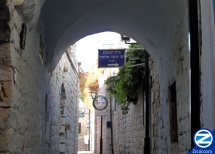Alsheich Synagogue Safed
 | |
| Hebrew: | |
|---|---|
| בית הכנסת אלשיך | |
| Pronunciation: | |
| Al-She-eich | |
| Description: | |
| Tzfat synagogue built by Turkish Jews and named for Rabbi Moshe Alsheich. |
The Alsheich Synagogue was built in the 16th century by Rabbi Moshe Alshich and his congregation of Turkish immigrants that included former Marano Bali Teshuva. Rabbi Moshe Alsheich insisted that no women’s section or restrooms be built on premises. The Alsheich Shul was the only old synagogue in Tzfat which was not destroyed by either the 1759 or the 1837 earthquakes. Originally named 'Kamis Istambulia', the shul was renamed in memory of the Alsheich after his passing. It is an important historical relic of Tzfat's Golden Age.
Contents |
[edit] Rabbi Moshe Alsheich
Rabbi Moshe Alsheich came to Tzfat from Turkey as part of the immigration of great Kabbalists who moved to the city. The Alsheich was a supporter of Rabbi Ya’akov Beirav’s plan to reinstate the Sanhedrin and was given ordination as a Rabbi of the Sanhedrin by Rabbi Yosef Karo who, himself, had been ordained by Rabbi Ya’akov Beirav. Rabbi Alsheich was one of the leading scholars and rabbinical arbitrators of the era. He created a number sefarim based on Drush.
[edit] Drush
Rabbi Alsheich was one of the foremost Darshanim scholars of his day. He gave weekly sermons on the Torah portion of the week at his synagogue which included insightful commentaries, that were attended even by the ARI. Once the ARI laughed during a sermon as the Alsheich was enumerating the ways that Laban tried to trick Jacob. The ARI explained, afterward, he laughed because as Rabbi Alsheich was talking, Laban was hovering in the corner, nodding as Rabbi Alsheich enumerated each of his attempted tricks.
[edit] Ba’alei Tshuva
One of the biggest dilemmas for the Jewish leadership of the 16th century was the question of how to relate to Jews who had converted to Christianity under the duress of the Spanish Inquisition and, after fleeing Spain and Portugal, sought to return to Judaism. Many rabbis refused to accept these Jews back into the fold, ruling that they had committed an unpardonable sin in publicly refuting Judaism and could not be reintegrated into the Jewish community.
Rabbi Alsheich was one of the rabbis who strongly supported the reabsorption of these Jews into the Jewish world. Together with Rabbi Beirav the Alsheich fought to convince the rabbinical authorities to accept the “ba’alei tshuva” back into Judaism. Ultimately this view prevailed.
![]() Read full Zissil article on Rabbi Moshe Alshich
Read full Zissil article on Rabbi Moshe Alshich
[edit] Kamis Istambulia
The Alsheich Synagogue was built by members of the congregation who, for the most part, came from Turkey, giving it the name 'Kamis Istambulia'. Some of these people were the ba’alei tshuva involved in the controversy, resulting in another name for the synagogue -- “The Synagogue of the Ba’alei Teshuva.” The synagogue was renamed the “Alsheich synagogue” after the Alsheich’s death.
[edit] Construction
Rabbi Moshe Alsheich oversaw the construction of the synagogue. It was erected in the style of 16th century Sepharadic synagogues. The Alsheich insisted that neither a women’s gallery nor any lavatory facilities be built on the synagogue premises. The Alsheich continued to pray and teach at the synagogue until he moved to Damascus in 1588. He returned to Tzfat in 1600 and is buried in the Tzfat cemetery.
[edit] Renovation
The synagogue withstood the earthquake of 1759. Shortly thereafter, the synagogue was renovated and the workmen inserted beams and peaked arches in the style of Bukharan Jews of Samarkand. This renovation was carried out due to the efforts of three people, Ya’acov Peleggi the builder, Yehezkel Reuven Menashe the philanthropist and Rabbi Ya’acov Anavti of Damascus, the intermediary. A plaque which is still visible above the sanctuary attests to the work of these individuals. The synagogue is also known as “Kenesset Yehezkel.”
[edit] 1837 Earthquake
The Alsheich synagogue is the only synagogue in Safed that withstood the 1837 earthquake. Some people attribute this to the arches and beams that were built during the renovation but others believe that the lack of a women’s gallery is the real reason that the synagogue was spared destruction.
[edit] Valued Artifact
One of the most valued artifacts in the synagogue is the Torah scroll cover inscribed with the Hebrew year 1434 and says “for the synagogue of the Ba’alei Teshuva” -- a reference to the ba’alei tshuva who returned to Judaism and built and worshiped at the Alsheich synagogue.
[edit] Today
The synagogue opens on the Sabbath for Sabbath prayers only. It is not accessible to tourists and tour groups. There is, to this day, no women’s gallery at the synagogue.
| |||||||||||
| ||||||||||||||
| |||||||||||||||||

